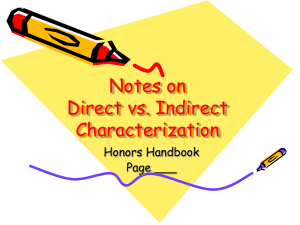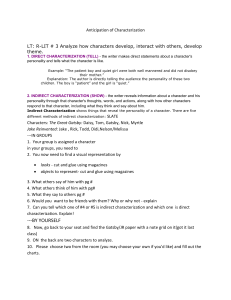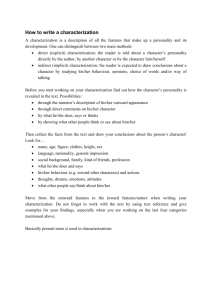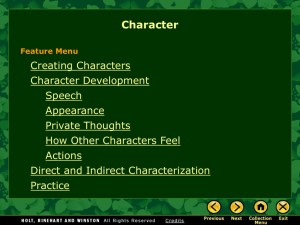Characterization
advertisement
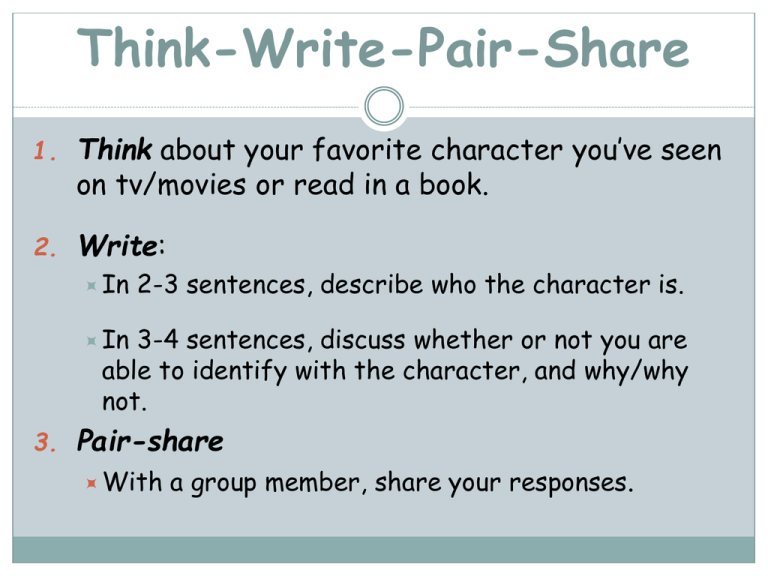
Think-Write-Pair-Share 1. Think about your favorite character you’ve seen on tv/movies or read in a book. 2. Write: In 2-3 sentences, describe who the character is. In 3-4 sentences, discuss whether or not you are able to identify with the character, and why/why not. 3. Pair-share With a group member, share your responses. Characterization How do writers bring characters to life? What is characterization? Characterization is the way writers create and describe a character for the reader. There are two types of characterization: Direct characterization Indirect characterization Direct characterization When writers use direct characterization in their writing, they tell us what type of character we are reading about: From “Ambush”: He was a short, slender young man of about twenty He wore black clothing and rubber sandals and a gray ammunition belt. His shoulders were slightly stooped, his head cocked to the side as if listening for something. He seemed at ease. He carried his weapon in one hand, muzzle down, moving without any hurry up the center of the trail. As readers, we don’t have to wonder about what the VietCong soldier looks like or what his demeanor is. The writer TOLD us DIRECTLY. For the character that corresponds to your number, provide a detail of him or her using direct characterization. 3 1 2 Indirect characterization Writers most often use indirect characterization to show (not tell) things that reveal the personality of a character: The character’s speech, The character’s thoughts, The effect the character has on others, The character’s actions, The physical “looks” of the character Indirect characterization It is more like the way we learn about people in real life because we naturally observe people and characters in films, etc. to figure out his/her/its personality. Remember the word, STEAL… “STEAL” The letters in the word “STEAL” can help you remember the five different ways writers use indirect characterization to create characters: “S” stands for SPEECH. Why it works: Writers help readers learn about a character by giving the character something to say and a unique way to say it. This brings out the personality of characters “STEAL” “T” stands for THOUGHTS. What can we learn about the character through reading his/her/its private thoughts? Why it works: Writers allow readers to learn the private thoughts of characters to learn the personality of characters. “STEAL” “E” stands for EFFECT ON OTHERS What can be learned about the character by reading how other characters feel or act around the him/her/it? Why it works: Writers create relationships for characters to help readers learn the personality of characters. “STEAL” “A” stands for ACTIONS. What does the character do? How does the character behave? Why it works: Writers create actions for characters to help readers learn the personality of characters. “STEAL” “L” stands for LOOKS. What does the character look like? How does the character dress? Why it works: Writers use descriptions of characters’ physical attributes to help readers learn the personality of characters. For the character that corresponds to your number, provide a detail of him or her using one STEAL indirect characterization strategy. 3 1 2 Direct or Indirect? Look at this example and figure out if the writer used direct or indirect characterization: From The Outsiders: (Sodapop talking to Ponyboy) “I'm happy working at a gas station. Working with cars. I'm dumb. It's alright, I don't mind. You're not Pony. You'd never be happy doing something like that.” Direct or Indirect? Look at this example and figure out if the writer used direct or indirect characterization to help us figure out the personality of Dallas Winston (Dally) in this passage: From The Outsiders: (Dally talking with Johnny) “Johnny, you don't know what a few months in jail can do to you, man. You get mean in jail, I just don't wanna see that happen to you like it happened to me, man. Understand?” Think-Write-Pair-Share 1. Think about the character known as “narrator” in “Ambush” by Tim O’Brien (page 81 in your SIR) 2. Write: In 2-3 sentences, explain the emotions the narrator experiences in the beginning-middle-end of the story. In 3-4 sentences, discuss whether or not you are empathetic to the narrator, and why/why not. 3. Pair-share Pair up with one person from the opposite side fo the room and share your responses.
